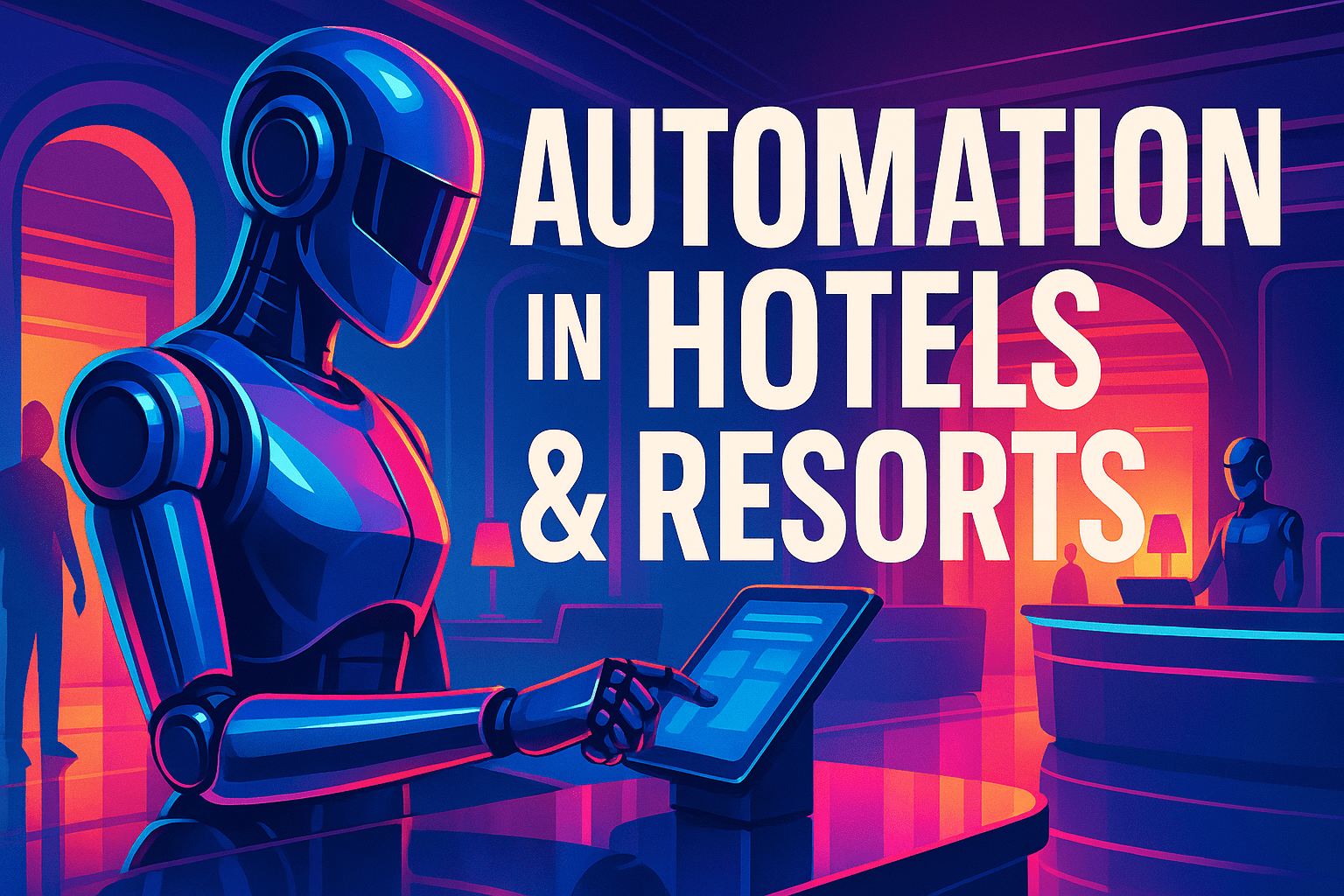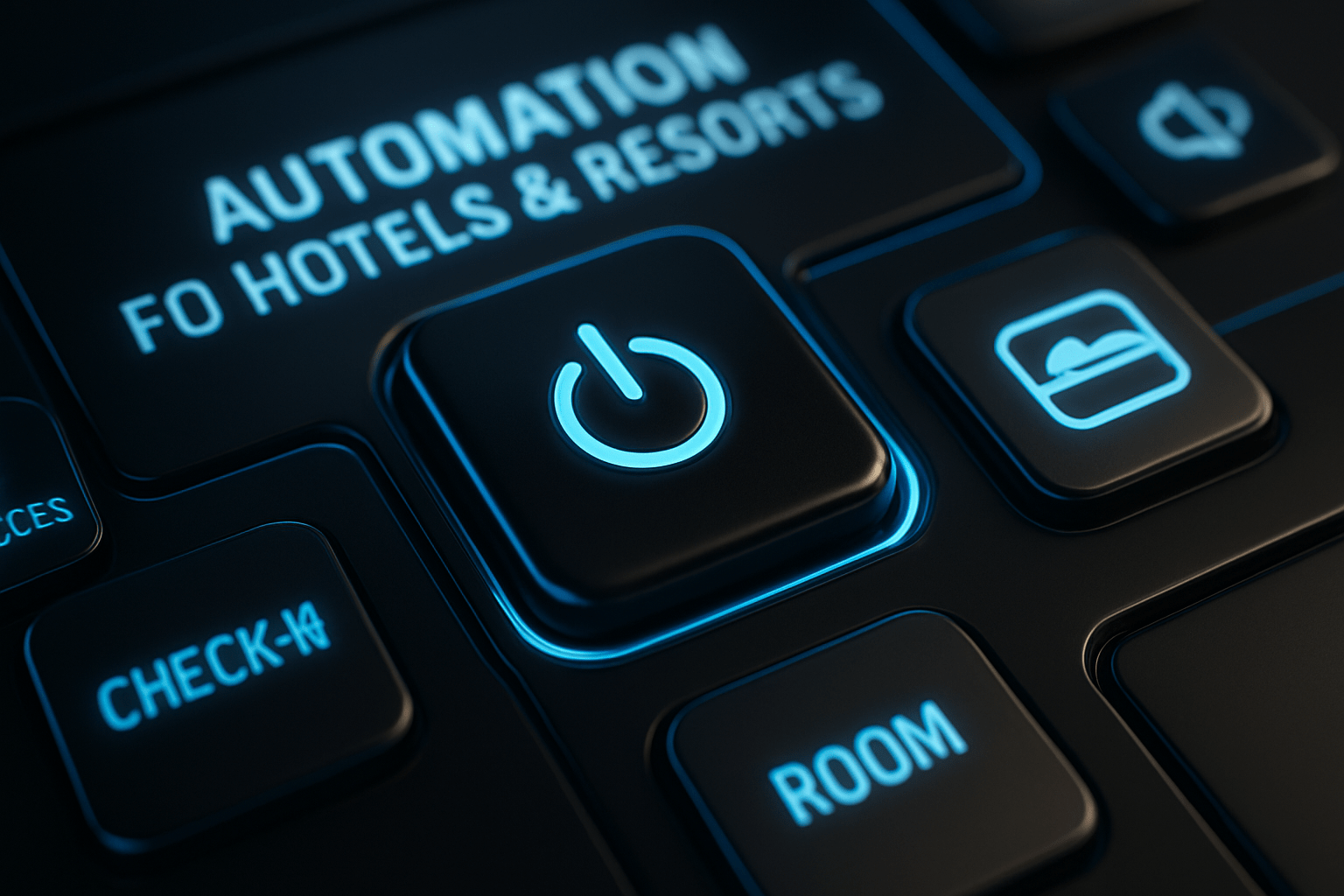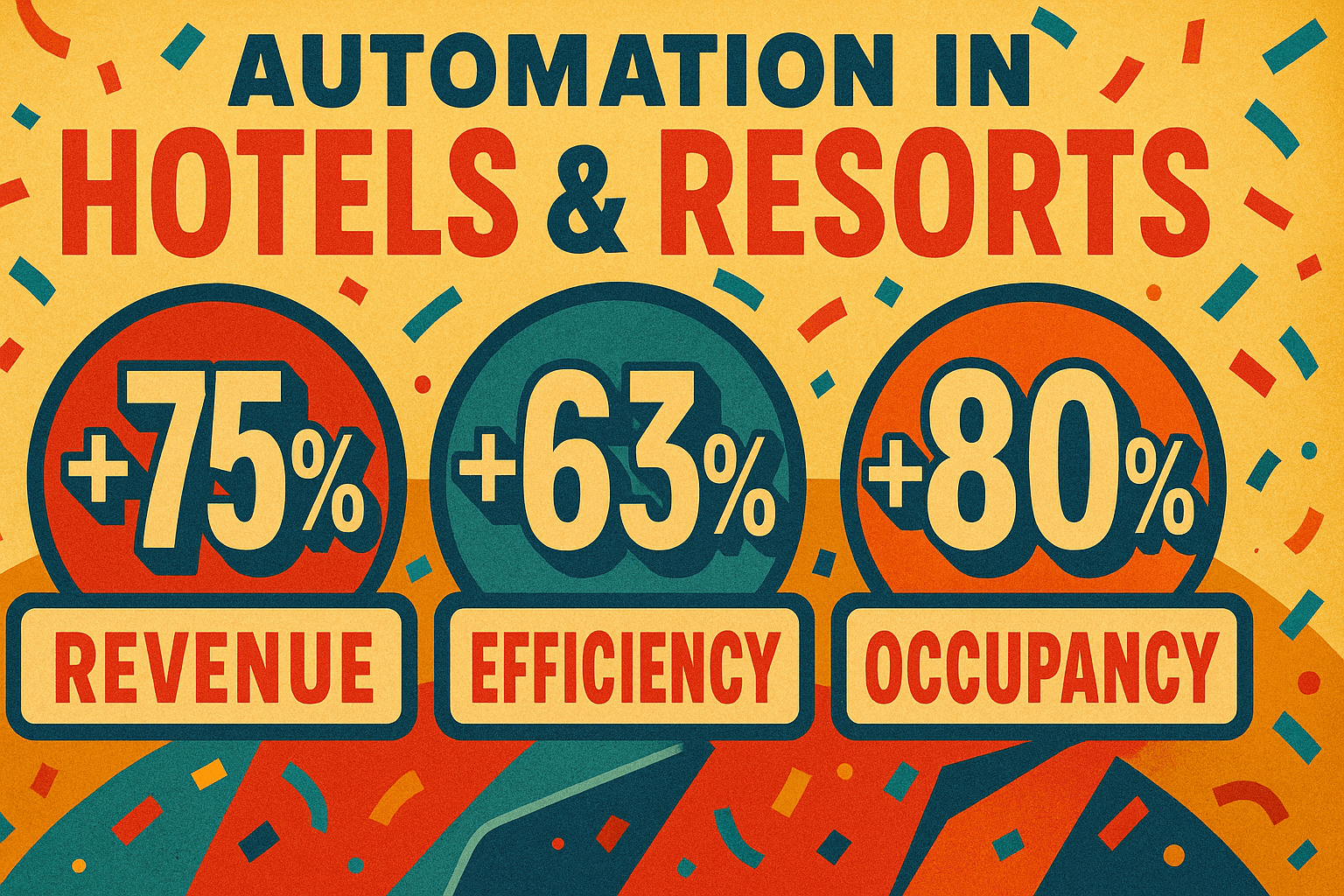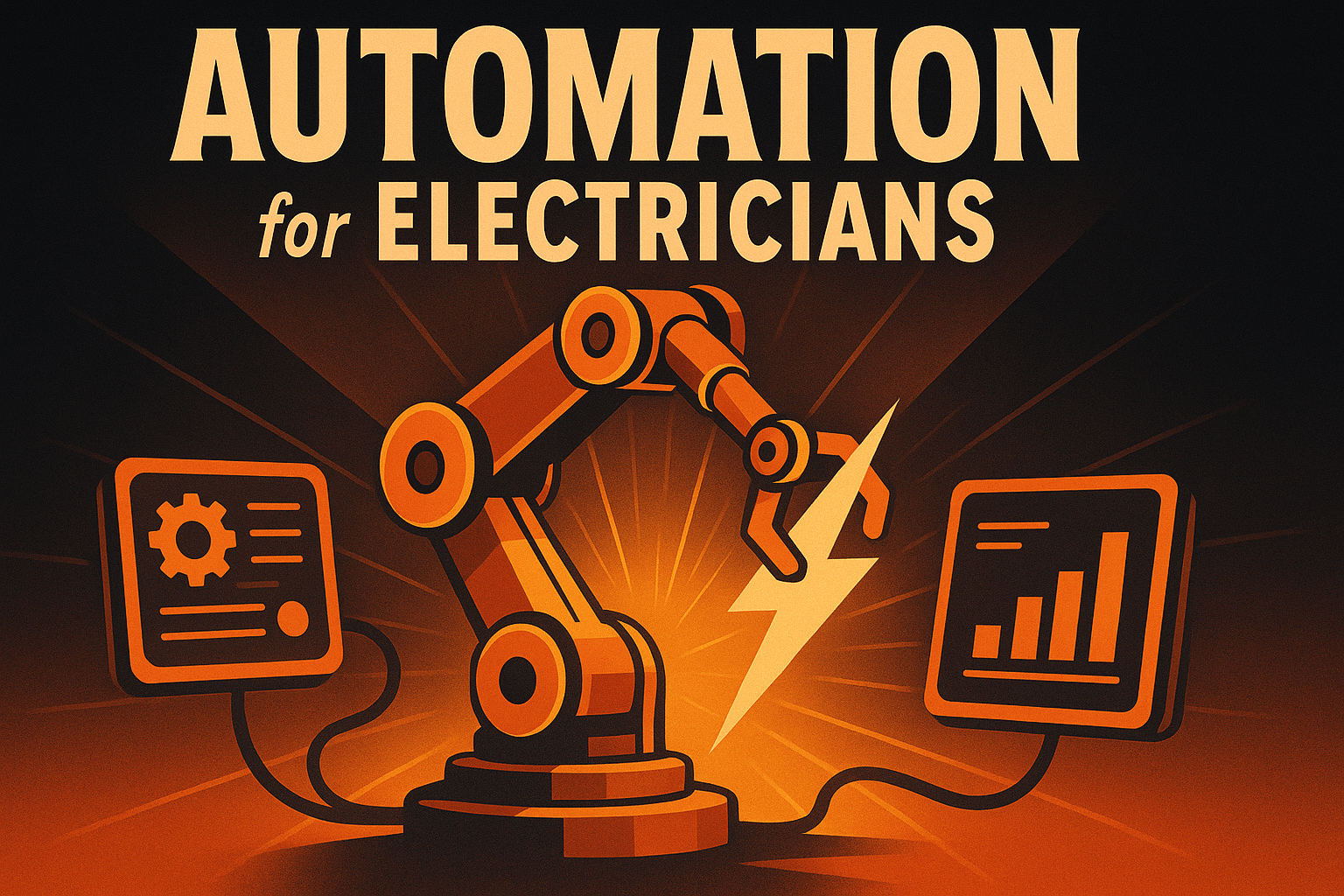Complete Automation Guide for Hotels & Resorts: Boost Efficiency and Revenue
by Design Delulu Editorial · October 22, 2025

Smart, fast, and measurable. Here's how Automation helps Hotels & Resorts win.
The hospitality industry faces unprecedented challenges: rising labor costs, fluctuating occupancy rates, and guest expectations that demand personalized experiences at scale. Hotels and resorts that embrace automation aren't just cutting costs—they're transforming how they compete, creating seamless guest journeys while freeing staff to focus on high-value interactions that drive loyalty and revenue.
Automation for hotels and resorts goes far beyond simple chatbots or automated emails. It's a comprehensive approach that connects marketing, operations, and guest experience into one intelligent system. From the moment a potential guest searches for accommodations to post-stay follow-ups that drive repeat bookings, strategic automation ensures every touchpoint is optimized, measured, and continuously improved based on real data.

Why Automation Is Critical for Modern Hospitality
The hotel and resort landscape has evolved dramatically. Today's travelers research across multiple devices, compare dozens of options, and expect instant responses regardless of time zone. Manual processes simply cannot keep pace with these demands while maintaining the operational efficiency needed to stay profitable.
Consider the typical guest journey: awareness through search or social media, comparison shopping across booking platforms, pre-arrival communication, on-property experience, and post-stay engagement. Each stage generates valuable data, requires timely responses, and presents opportunities for upsells or service recovery. Without automation, properties struggle to capture this data, respond promptly, and make informed decisions.
Key challenges automation solves:
- Data fragmentation: Guest information scattered across booking engines, PMS systems, CRM platforms, and marketing tools creates blind spots and missed opportunities
- Inconsistent tracking: Without proper measurement, you can't determine which marketing channels drive qualified bookings or calculate true guest acquisition costs
- Revenue leakage: Manual processes miss upsell opportunities, fail to optimize pricing dynamically, and lack the speed to respond to market changes
- Staff burnout: Repetitive tasks consume time that should be spent on guest interactions, while understaffing during peak periods damages service quality
- Attribution gaps: Marketing teams can't prove ROI when they don't know which campaigns, keywords, or touchpoints actually convert browsers into bookers
Progressive properties are using automation to bridge these gaps, creating unified systems that work 24/7 to maximize occupancy, increase average daily rate (ADR), and enhance guest satisfaction scores—all while reducing operational overhead.
Core Automation Systems That Drive Results
Effective hotel and resort automation isn't about implementing every available tool. It's about building an integrated ecosystem where marketing automation, revenue management, and guest experience systems work in harmony. Here's how the most successful properties structure their automation strategy:
Marketing & Acquisition Automation
Your marketing automation foundation determines whether you're flying blind or making data-driven decisions. This system captures every interaction from first touch to booking confirmation.
Essential components include:
- Advanced tracking implementation: GA4 with enhanced ecommerce events, server-side tagging for accuracy, and cross-domain tracking to follow guests from social ads through booking engines
- Multi-touch attribution modeling: Understand which channels assist versus convert, allocate budget to high-performing sources, and identify the optimal marketing mix for your property type
- Automated campaign optimization: Bid adjustments based on real booking data, audience segmentation by stay type and value, and dynamic retargeting based on browsing behavior
- Lead scoring and nurturing: Automatically identify high-intent visitors, trigger personalized email sequences, and alert sales teams when VIP prospects engage
Properties using sophisticated marketing automation typically see 20-35% improvements in marketing efficiency within the first quarter, as they shift spend away from vanity metrics toward channels that drive actual revenue.
Revenue Management Automation
Dynamic pricing and yield management are no longer optional for competitive properties. Automation enables real-time pricing adjustments based on demand signals, competitor rates, and historical patterns.
Critical capabilities:
- Demand forecasting: Machine learning models analyze booking pace, market conditions, local events, and seasonal patterns to predict optimal pricing windows
- Competitive intelligence: Automated rate shopping monitors competitor pricing across all major OTAs and direct booking channels
- Inventory optimization: Intelligent overbooking algorithms and room-type substitution rules that maximize revenue without creating guest service issues
- Package and ancillary automation: Dynamic bundling of room rates with spa services, dining, activities, or upgrades based on guest profiles and availability
Guest Experience Automation
The most effective automation is invisible to guests—it simply makes their experience seamless and personalized without feeling robotic or impersonal.
High-impact implementations:
- Pre-arrival communication: Automated yet personalized emails with arrival details, local recommendations based on guest preferences, and opportunities to pre-book experiences
- Smart room assignments: Algorithms that match guests to ideal rooms based on past stays, special requests, and loyalty status
- Service recovery triggers: Automated alerts when negative sentiment is detected in guest communications or social media, enabling immediate intervention
- Post-stay engagement: Triggered review requests sent at optimal times, personalized offers for future stays, and loyalty point updates

Implementation Framework: From Strategy to Scale
Successful automation isn't about technology—it's about aligning systems with your specific business model, guest segments, and operational capabilities. Here's the proven framework that minimizes disruption while maximizing impact:
Phase 1: Discovery & Strategic Alignment
Before implementing any tools, clarify what success looks like and what constraints you're working within. This foundation prevents costly mistakes and ensures buy-in across departments.
Key activities:
- Audit current systems, data flows, and integration points to identify gaps and redundancies
- Map the complete guest journey from awareness to advocacy, noting all touchpoints and handoffs
- Define primary KPIs tied to revenue (direct bookings, ADR, RevPAR) and supporting metrics (engagement rates, conversion rates by channel)
- Assess team capabilities and identify training needs or role adjustments required for success
- Establish governance framework for data quality, privacy compliance, and ongoing maintenance
This phase typically requires 1-2 weeks but prevents months of rework when systems don't align with business objectives or integrate poorly with existing technology.
Phase 2: Architecture & Measurement Blueprint
With strategy defined, design the technical architecture and measurement framework that will power your automation ecosystem.
Deliverables include:
- Data layer specification: Define all events, parameters, and user properties to be tracked across platforms
- Integration map: Document how PMS, booking engine, CRM, marketing platforms, and analytics tools connect and share data
- Attribution model design: Select and configure the attribution approach that best reflects your sales cycle and channel mix
- Dashboard framework: Design executive, marketing, and operational dashboards that provide actionable insights without overwhelming users
- Privacy and compliance plan: Ensure GDPR, CCPA, and other regulations are addressed in data collection and usage
Invest time here to get this right. A solid blueprint allows for rapid implementation and makes future optimizations straightforward rather than requiring complete rebuilds.
Phase 3: Build, Test & Deploy
Implementation should be phased to minimize risk and allow for learning before full-scale deployment.
Recommended sequence:
- Tracking foundation (Week 1-2): Implement GA4, server-side tagging, and core event tracking; validate data accuracy in staging environment
- Integration configuration (Week 2-3): Connect PMS, booking engine, and CRM systems; test data flows and establish automated quality checks
- Dashboard deployment (Week 3-4): Build and deploy primary dashboards with historical data; train stakeholders on interpretation and usage
- Marketing automation (Week 4-6): Configure campaign tracking, attribution models, and automated reporting; implement initial optimization rules
- Guest experience automation (Week 6-8): Deploy triggered communications, personalization engines, and service recovery alerts; start with high-impact, low-risk implementations
Throughout deployment, maintain a robust QA process that includes: synthetic transaction testing, data validation against known sources, user acceptance testing with actual team members, and staged rollouts that allow for quick rollback if issues emerge.
Phase 4: Optimize & Scale
Automation isn't a set-it-and-forget-it solution. The most successful properties treat it as a continuous improvement engine.
Optimization cadence:
- Weekly reviews: Examine dashboard metrics, identify anomalies or opportunities, and make tactical adjustments to campaigns or automations
- Monthly analysis: Deep-dive into attribution data, guest journey paths, and conversion funnel performance; test new hypotheses and automation rules
- Quarterly strategic sessions: Assess whether KPIs remain aligned with business goals, evaluate new technology opportunities, and plan major enhancements
Properties that maintain this discipline see compounding returns over time, as each optimization builds on previous wins and the system becomes increasingly tuned to your specific market dynamics.
Measuring Success: KPIs That Matter
The right metrics tell you whether your automation investment is paying off. Focus on outcomes, not activities—vanity metrics like email open rates or website sessions don't pay the bills.
Revenue-Focused Metrics
These are your north star metrics—if these improve, your automation is working:
- Direct booking percentage: Track the share of bookings coming through your website versus OTAs; successful automation should increase this by 5-15 percentage points
- Guest acquisition cost (GAC) by channel: Total marketing spend divided by new guests acquired; automation should reduce this by 15-30% as you eliminate waste
- Revenue per available room (RevPAR): The ultimate profitability metric; automation's impact here comes from optimized pricing and increased occupancy
- Average daily rate (ADR): Better attribution and personalization should enable premium pricing without occupancy loss
- Lifetime guest value (LTV): Post-stay automation and loyalty programs should increase repeat booking rates and guest tenure
Operational Efficiency Metrics
These metrics demonstrate how automation frees up your team and reduces overhead:
- Time saved per booking: Measure reduction in manual tasks from inquiry to confirmation; target 30-50% time savings
- Response time to guest inquiries: Automation should reduce average response time from hours to minutes for common questions
- Data accuracy rate: Percentage of guest records with complete, accurate information; should approach 95%+ with proper automation
- Labor cost as percentage of revenue: Well-implemented automation reduces this by 3-7 percentage points while maintaining or improving service levels
Guest Experience Metrics
Ensure automation enhances rather than diminishes the human touch:
- Guest satisfaction scores (GSAT): Monitor for any decline that might indicate automation feels impersonal
- Online review ratings and volume: Automated review solicitation should increase volume; quality should remain stable or improve
- Complaint resolution time: Service recovery automation should dramatically reduce time from issue identification to resolution
- Personalization effectiveness: Track engagement rates with personalized communications versus generic ones

Industry-Specific Best Practices for Hotels & Resorts
Hospitality automation has unique requirements that differ from other industries. These proven practices help hotels and resorts maximize results while avoiding common pitfalls:
Align Automation to the Guest Journey
Map your automation to how guests actually book, not how you wish they would:
- Awareness stage: Use SEO automation to capture high-intent searches like "family resort in [destination]" or "boutique hotel near [landmark]"
- Consideration stage: Deploy retargeting with social proof (recent reviews, awards, unique amenities) and scarcity signals (rooms remaining, special offer deadlines)
- Decision stage: Implement abandoned booking recovery with personalized incentives; test different timing and offer strategies
- Experience stage: Automate pre-arrival communication, arrival day welcome messages, and in-stay upsell opportunities
- Advocacy stage: Trigger review requests at optimal times (typically 3-5 days post-checkout), segment by experience quality, offer incentives for loyalty program referrals
Leverage Seasonality and Event Data
Hotels and resorts face dramatic demand fluctuations. Smart automation anticipates and capitalizes on these patterns:
- Build event calendars that trigger pricing adjustments, marketing campaigns, and inventory holds automatically when conferences, festivals, or local events are scheduled
- Create seasonal campaigns that activate and deactivate based on calendar dates and booking pace, not manual intervention
- Implement dynamic minimum length-of-stay rules that adjust automatically based on demand forecasts for weekend versus weekday arrivals
- Use historical data to predict booking windows by season and automate marketing intensity accordingly (e.g., summer bookings often happen 90+ days out; winter getaways book within 30 days)
Integrate With Existing Hotel Technology
Your automation is only as good as your integrations. Ensure seamless data flow between:
- Property Management System (PMS): Real-time inventory, guest profiles, and stay history must feed your marketing automation
- Channel Manager: Rate and availability updates should sync instantly across all distribution channels
- Revenue Management System (RMS): Pricing recommendations should automatically update based on competitor data and demand signals
- Customer Relationship Management (CRM): Guest preferences, communication history, and value scores should inform all automated touchpoints
- Payment and booking engines: Transaction data must flow to analytics platforms for accurate attribution and revenue reporting
Balance Automation With Authentic Hospitality
The risk with automation is creating experiences that feel mechanical. Avoid this by:
- Writing in your brand voice: Automated emails should read like they came from a knowledgeable concierge, not a robot
- Adding human touches: Include staff member names and photos in automated communications; empower your team to override automation when a personal touch is needed
- Responding to context: Use conditional logic so automated messages adapt to circumstances (celebration stays get different messaging than business trips)
- Escalating appropriately: Design automation to recognize when issues require human intervention and route them to the right team member immediately
- Testing with real guests: Don't just QA technically—have team members and loyal guests experience your automation and provide feedback
Start With High-Impact, Low-Complexity Wins
You don't need to automate everything on day one. Prioritize implementations that deliver fast ROI with minimal risk:
Quick wins to implement first:
- Email marketing automation: Welcome series, pre-arrival communications, and post-stay follow-ups typically show 30-50% open rates and drive measurable direct bookings
- Review generation: Automated review requests can increase review volume by 200-400%, improving online visibility and providing valuable feedback
- Abandoned booking recovery: Simple email sequences to guests who started but didn't complete booking can recover 5-15% of abandoned carts
- Basic attribution tracking: Understanding which channels drive bookings versus just website visits allows immediate budget reallocation to high-performing sources
- Occupancy-based campaigns: Automatically increase marketing spend when occupancy forecast falls below target helps smooth demand fluctuations
After proving value with these foundational elements, expand to more sophisticated implementations like dynamic pricing, predictive analytics, and AI-powered personalization.
Common Pitfalls and How to Avoid Them
Many hotels and resorts stumble in predictable ways when implementing automation. Learn from these common mistakes:
Technology Before Strategy
The mistake: Buying tools without clear objectives, then struggling to figure out how to use them effectively.
The solution: Start with business goals and guest pain points. Select technology that addresses specific, measurable challenges. If you can't articulate the problem being solved, don't buy the tool.
Data Silos and Integration Gaps
The mistake: Implementing automation systems that don't communicate with each other, creating duplicated data, manual workarounds, and blind spots.
The solution: Map all data flows before implementation. Insist on platforms with robust APIs and native integrations with your core systems. Budget for integration development when necessary.
Set-and-Forget Mentality
The mistake: Treating automation as a one-time project rather than an ongoing optimization engine.
The solution: Establish regular review cadences, assign ownership for each automation system, and create a culture of continuous improvement based on performance data.
Over-Automation
The mistake: Automating interactions that genuinely benefit from human touch, creating frustrating guest experiences.
The solution: Reserve automation for repetitive tasks and information delivery. Keep humans involved in complex problem-solving, empathy-requiring situations, and VIP guest interactions.
Poor Data Quality
The mistake: Building automation on top of incomplete, inaccurate, or inconsistent data, leading to wrong decisions and guest frustration.
The solution: Implement data governance policies, validation rules, and regular audits. Clean existing data before automation launch, not after.
Neglecting Mobile Experience
The mistake: Designing automation for desktop users when 60-70% of hotel searches happen on mobile devices.
The solution: Test all automated communications, landing pages, and booking flows on mobile devices. Optimize for small screens, slower connections, and touch interfaces.
Building Your Automation Roadmap
Ready to implement automation at your property? Use this roadmap to sequence your initiatives for maximum impact with minimum disruption:
Months 1-2: Foundation
- Audit current systems and identify integration requirements
- Implement comprehensive tracking (GA4, server-side tagging, event measurement)
- Build core dashboards for marketing, revenue, and operations teams
- Launch basic email automation (welcome series, pre-arrival, post-stay)
- Establish KPI benchmarks and reporting cadence
Months 3-4: Marketing Optimization
- Deploy attribution modeling and shift budget to high-performing channels
- Implement abandoned booking recovery campaigns
- Launch automated review generation and reputation monitoring
- Set up dynamic retargeting based on browse behavior and booking stage
- Create automated lead scoring and sales team alerts for high-value inquiries
Months 5-6: Revenue Management
- Integrate RMS with automated pricing adjustments based on demand signals
- Implement competitor rate monitoring and alerting
- Deploy dynamic packaging and ancillary upsell automation
- Create event-triggered marketing campaigns (local festivals, conferences, etc.)
- Optimize inventory allocation across distribution channels automatically
Months 7-9: Guest Experience Enhancement
- Deploy personalization engine using guest preference data and stay history
- Implement service recovery automation with sentiment analysis
- Launch loyalty program automation with tier management and rewards
- Create automated upsell opportunities during stay (spa, dining, late checkout)
- Build predictive models for guest needs and proactive service delivery
Months 10-12: Scale and Advanced Capabilities
- Implement AI-powered chatbots for common guest inquiries
- Deploy predictive analytics for demand forecasting and labor scheduling
- Create closed-loop reporting that connects every marketing dollar to revenue generated
- Expand automation to additional properties or room types
- Build custom integrations for unique property requirements
Real-World Results: What to Expect
Properties that implement comprehensive automation thoughtfully typically see these outcomes within the first year:
- Direct bookings increase 15-35% as attribution clarity enables better marketing decisions and personalized campaigns improve conversion rates
- Marketing efficiency improves 20-40% as spending shifts to proven channels and automated optimization eliminates waste
- Guest acquisition cost drops 15-30% through better targeting, conversion optimization, and reduced reliance on expensive OTA commissions
- Staff productivity increases 25-50% for routine tasks like pre-arrival communication, review management, and inquiry response
- Revenue per booking grows 8-15% through dynamic pricing, personalized upsells, and optimized packaging
- Guest satisfaction remains stable or improves when automation is implemented with hospitality principles in mind
These aren't aspirational numbers—they reflect actual results from properties that commit to the full implementation framework rather than piecemeal technology adoption.
Getting Started: Your Next Steps
Automation for hotels and resorts isn't about replacing the human element—it's about amplifying it. By handling repetitive tasks, providing data-driven insights, and enabling personalization at scale, automation frees your team to deliver the exceptional experiences that create loyal guests and drive sustainable revenue growth.
To begin your automation journey:
- Assess your current state: Document existing systems, integrations, and pain points. Identify your most pressing challenges and highest-impact opportunities.
- Define success metrics: Establish baseline KPIs and set realistic targets for improvement. Focus on revenue-driving metrics, not vanity numbers.
- Start small but strategic: Choose 2-3 high-impact, low-complexity implementations to prove value quickly and build organizational confidence.
- Plan for integration: Ensure any automation tools can connect with your PMS, booking engine, and other core systems.
- Commit to optimization: Automation isn't a project—it's a capability. Build the discipline and resources to continuously improve based on performance data.
The properties that thrive in today's competitive hospitality landscape aren't the ones with the most tools—they're the ones with the smartest systems, working together seamlessly to create remarkable guest experiences while driving measurable business results.
Frequently Asked Questions
Let’s level up your Hotels & Resorts business
Need services that actually move the needle for Hotels & Resorts? See our approach, pricing, and timelines—then book a quick call.
Additional Resources
- Schedule Your Automation Strategy Call
Book a complimentary 30-minute consultation to discuss your property's automation opportunities. We'll review your current systems, identify high-impact improvements, and outline a customized implementation roadmap with transparent pricing and timelines.
- View Our Hotel & Resort Portfolio
Explore real-world automation projects we've delivered for hotels and resorts. See case studies showcasing measurable improvements in direct bookings, guest engagement, and operational efficiency across boutique properties, luxury resorts, and hotel chains.
- Free Hotel Marketing & Automation Tools
Access free resources designed specifically for hotels and resorts: marketing calculators, automation checklists, tracking templates, and ROI estimators. Get practical tools to start optimizing your operations immediately, no strings attached.
Related Reading

Discover how automation for electricians streamlines scheduling, invoicing, lead tracking, and customer follow-ups to boost revenue and efficiency. Get started today.

Discover how automation streamlines furniture & home decor operations with GA4 tracking, attribution modeling, and data-driven dashboards. Get your 90-day implementation roadmap.
